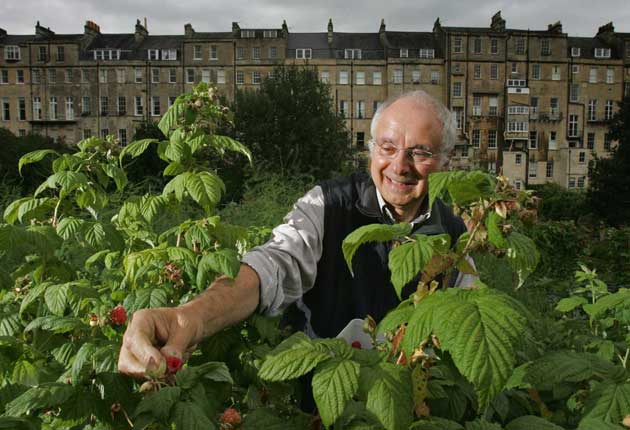Allotments: A patch of your own
Home-grown produce and plenty of fresh air – no wonder demand for allotments is soaring. Graham Norwood investigates

Financial chaos and a renewed interest in healthy eating are combining |to keep at least one small sector |of the property market buoyant: the allotment. There are 245,000 allotments throughout Britain today, yet more than 100,000 people are on waiting lists to start growing their own food should a plot become free. Deborah Malone, 48, a council employee from Redland in Bristol, is a typical enthusiast. “I tend my allotment at least twice a week, even in the winter. I’m growing kale, purple-sprouting broccoli and Brussels sprouts, even though I don’t eat sprouts. Allotment veggies are cheaper and better than you would buy in a shop, but they also give city dwellers a chance to be physically creative, which is rare these days,” she says.
That sense of growing your own complements the interest in the provenance of food and concern over environmental damage done by food miles, and means that allotments are enjoying a renaissance. A survey by the website Findaproperty.com shows that 77 per cent of Britons want one, and 58 per cent urge councils to give local residents space for allotments by providing them with disused land.
Even developers are getting in on the act. The Wintles, an estate of “eco-properties” built in Shropshire in 2005, includes allotments |for its residents. Crest Nicholson has rooftop allotments on a development being built in Brighton, as well as more traditional versions on another development in Suffolk.
Cambourne, a 3,000-home project near Cambridge being built jointly by Bovis, Bryant and George Wimpey is typical of many new |village-style schemes in that it boasts a thriving community of growers, who use its 68 plots.
Allotment historians – yes, they do exist – say many allotments were built over as our urban conurbations enlarged. But the increasing density of UK cities, especially since the advent of large-scale apartment blocks in the 1990s, has made allotments popular again with city-dwellers denied a garden – or even a window box – of their own.
The idea of parcelling land for locals dates back to at least 1732. By 1873 there were 244,000 plots, and by the First World War there were 1.5 million. In the late 1940s, there were still 1.17 million, but as urban development accelerated, that number |fell to 250,000 by |the 1990s.
That is still the figure today. What has changed, though, is demand: it is soaring.
“Demand for allotments is at an all-time high,” says Mark Hedges, the editor of Country Life magazine. “In some areas, such as London, there’s a 10-year waiting list for a plot. We need more. There are many wasted acres near towns and villages that could – and indeed should – be given over to allotments.”
Many councils outside Greater London have policies and at least one officer responsible for allocating allotments, and there may be privately run spaces – farmers often divide fallow fields for allotment enthusiasts. But be patient: allotment holders are notoriously unwilling to give up their plots, so turnover is slow.
Allotments cost £10-£60 per year for a standard 30ft by 20ft plot. Some allow gardeners to sell their produce directly from the allotment, too, for a quick return on one’s efforts.
Plots have a therapeutic value as well as a horticultural one. Diggin’ It is an organic allotment run by people in a deprived area of Plymouth; in Nottingham, the Ecoworks allotment is run in a similar way.
There is a financial dividend, too. Produce grown in allotments costs a fraction of what |it would in a supermarket, says Terry Walton, who runs Radio 2’s “house allotment” in the Rhondda Valley, featured on The Jeremy Vine Show. His calculations indicate that a kilogram of carrots grown on an allotment costs 4p, compared with 78p in a supermarket. Allotment potatoes cost 40p/kg, but £1.08 in a supermarket.
For people such as Deborah Malone, however, an allotment means more than money. “I work at a computer five days a week, driving to and from an office, and don’t have much by way of creativity on weekdays,” she says. “So the allotment is my way of keeping fit, meeting other people, communing with nature, breathing fresh air and producing healthy food. What else would I want?”
Down and dirty: How to bring your allotment to life
You wait two years on a council waiting list and you’ve finally got your allotment. But what are the next steps?
* Grow on a full or half plot – some allotments allow you to sub-let part of your space
* Cover unused areas with old carpet to deter weeds and bugs
* Lay crops in rows (to make hoeing easy) or in separated beds
* Use herbicides to kill off perennial weeds, in particular the dreaded bindweed
* Check if rules prevent intensive growing in greenhouses or polytunnels
* Grow fruit and veg based on your budget, taste and spare time
* Rotate growth areas over the years to deter soil-borne pests and diseases
* Stagger sowing to ensure a regular crop of vegetables all year round
* Use cloches, fleece and transplants to lengthen the growing season
* Don’t be over-ambitious – take your time.
Source: National Society of Allotment and Leisure Gardeners ( www.nsalg.org.uk )
Join our commenting forum
Join thought-provoking conversations, follow other Independent readers and see their replies
Comments